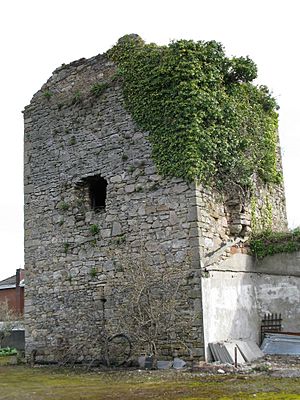Siege of Clonmel facts for kids
Quick facts for kids Siege of Clonmel |
|||||||
|---|---|---|---|---|---|---|---|
| Part of the Cromwellian Conquest of Ireland | |||||||
 One of the remaining towers, part of the western defensive wall at the time of the siege. |
|||||||
|
|||||||
| Belligerents | |||||||
| Commanders and leaders | |||||||
| Strength | |||||||
| 1,500 | 8,000 | ||||||
| Casualties and losses | |||||||
| Several hundred | Up to 2,000 | ||||||
The Siege of Clonmel was a big battle that happened in Clonmel, County Tipperary, Ireland. It took place from April 27 to May 18, 1650. This siege was part of the Cromwellian conquest of Ireland, when the English army, led by Oliver Cromwell, was trying to take control of Ireland.
About 8,000 English soldiers, part of Cromwell's "New Model Army," surrounded Clonmel. Inside the town, there were 1,500 Irish soldiers led by Hugh Dubh O'Neill. Even though the Irish were outnumbered, they fought bravely and caused many losses for Cromwell's army. In the end, the Irish surrendered, but O'Neill and some of his troops managed to escape. This battle was a major moment, as it greatly weakened the Irish resistance in Ireland.
Contents
Why Clonmel Was Important
Before the siege began, the town of Clonmel was preparing for a fight. The Mayor, John Bennet White, asked for military help. At first, some soldiers from County Clare arrived. However, the townspeople didn't fully trust them.
So, these soldiers were replaced by experienced fighters from Ulster. These new troops were led by Hugh O'Neill, who was very skilled in defending towns. He had 1,500 soldiers, many from Tyrone and Cavan, and two groups of cavalry. O'Neill also sent extra soldiers to protect smaller forts nearby.
Supplying all these soldiers was a challenge. Even before the English army arrived, there wasn't enough food. Other nearby towns had given up easily, which made the people in Clonmel even more worried.
Cromwell was in a hurry to capture Clonmel. He had been called back to England to deal with problems there. Because of this, he decided to try and take the town quickly by attacking it directly, instead of waiting for a long siege.
The Attack on the Walls
Cromwell's army used their powerful cannons to blast a hole in Clonmel's town walls. This hole was called a "breach." The plan was for his foot soldiers (infantry) to rush through this hole. After getting inside, they would open the nearby North town gate for Cromwell and his cavalry (soldiers on horseback).
However, Hugh O'Neill was very clever. He made all the people in Clonmel, even the regular citizens, help build a hidden defense inside the breach. This defense was shaped like a "V" and was filled with cannons, muskets (guns), and pikemen (soldiers with long spears).
At the narrow end of this V-shaped defense, O'Neill placed two cannons. These cannons were loaded with "chain-shot," which were two cannonballs connected by a chain. When fired, they would spin and cause terrible damage. The area behind the breach became a "killing field" for anyone trying to get through.
When the English foot soldiers attacked the breach, they were met with fierce resistance. The pikemen fought them, and marksmen shot them down from behind the earthworks. The English soldiers were cut down again and again. Eventually, they refused to attack this deadly trap anymore.
Cromwell then asked his best cavalry, the "Ironsides," to attack on foot. This time, the Irish let them enter without much resistance at first.
An English officer described what happened next. The Ironsides rushed into the narrow lane inside the breach. The lane quickly became packed with soldiers. Those at the front realized they were trapped and shouted "Halt! Halt!" But those behind them, thinking the Irish were running away, shouted "Advance! Advance!" They pushed forward until the lane was completely full.
Suddenly, O'Neill's soldiers attacked. They fired shots, used pikes, scythes (large blades), and even threw big pieces of timber with special machines. The two cannons at the end of the lane fired their chain-shot. In less than an hour, about a thousand English soldiers were killed in that packed lane. They were piled on top of each other.
Cromwell was waiting with another group of soldiers for the North gate to be opened. When he saw that the first attack had failed and night was coming, he decided to stop the attack for the day. He knew that even if his soldiers tried again, it would be pointless against O'Neill's strong defenses without more cannon support.
The Surrender
Cromwell knew that O'Neill's soldiers were running low on ammunition and supplies. He planned to attack again the next morning with his cannons firing directly at O'Neill's inner defenses.
But during the night, O'Neill's men quietly slipped away from Clonmel. They made their way to Waterford, another city. Cromwell didn't know this. He thought Clonmel was still heavily defended.
So, Cromwell talked with the town's mayor, John White, to arrange a surrender. The terms of surrender said that the lives and property of the townspeople would be safe. After they agreed, Cromwell found out that O'Neill and his soldiers had tricked him and escaped.
Cromwell was very angry about being fooled. However, he kept his promise. He made sure his soldiers followed the surrender agreement and treated the people of Clonmel and their belongings with respect.
What Happened Next
The Siege of Clonmel lasted for five weeks. Cromwell's army suffered heavy losses, losing between 2,000 and 2,500 soldiers. Hundreds more were wounded. This was the largest number of soldiers Cromwell's New Model Army had ever lost in a single battle.
Even though the Irish Confederate Wars continued for a few more years, the fall of Clonmel effectively ended the main resistance against Cromwell in Ireland. After the siege, Oliver Cromwell returned to England.
More to Explore
- Wars of the Three Kingdoms
- Irish battles

